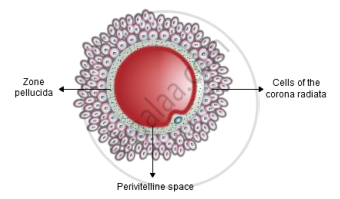Advertisements
Advertisements
प्रश्न
The following is the illustration of the sequence of ovarian events (a − i) in a human female

(i) Identify the figure that illustrates ovulation and mention the stage of oogenesis it represents.
(ii) Name the ovarian hormone and the pituitary hormone that have caused the above mentioned event.
(iii) Explain the changes that occur in the uterus simultaneously in anticipation.
(iv) Write the difference between ‘c’ and ‘h’.
(v) Draw a labeled sketch of the structure of a human ovum prior to fertilization.
उत्तर
(i) Figure 'f' illustrates ovulation. It represents the ovulatory stage of oogenesis.
(ii) Progesterone is the ovarian hormone released during ovulation. Follicle stimulating hormone (FSH) and Luteinizing hormone (LH) are the pituitary hormone released during ovulation.
(iii) In anticipation of receiving the fertilised egg, the endometrium of the uterus gets thickened and also the blood supply to the endometrium increases.
(iv) In the figure, (c) stage represents the secondary follicle and the (h) stage represents the degenerating corpus luteum.
|
Secondary follicle |
Corpus luteum |
|
It is Surrounded by layers of granulosa cells |
Layers of granulosa cells absent |
|
Presence of theca layer |
No theca layer is present |
(v) Labeled diagram of the human ovum prior to fertilization.

संबंधित प्रश्न
The process of release of the ovum from a mature follicle is called __________.
Name the functions - Acrosome of sperm.
Explain the structure of secondary oocyte.
Explain two main process in sexual reproduction.
Answer the following type of question Assertion (A) and Reason (R).
(A) - In human males, testes are extra-abdominal and lie in scrotal sacs.
(R) - Scrotum acts as a thermoregulator and keeps the temperature lower by 2°C for normal sperm production.
Define gametogenesis.
During spermatogenesis, spermatogonium grows in size to become ______.
The immature male germ cells differentiates into ______ at the end of meiosis I.
Cells of corona radiata remain grouped together by ______.
The spermatogonia undergo division to produce sperms by the process of spermatogenesis. Choose the correct one with reference to above.
